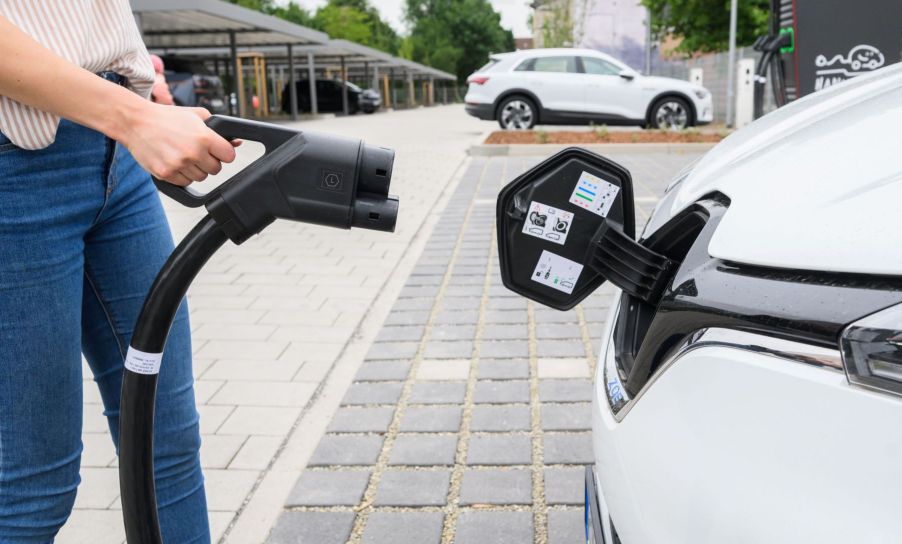
How Long Does It Take to Charge a Plug-in Hybrid Electric Vehicle (PHEV) With Level 3 Charging?
A plug-in hybrid electric vehicle, or PHEV, as the name suggests, is similar to an EV in many aspects, but it is also distinct in others. PHEVs, for instance, can function in a battery-only mode just like EVs, although at a reduced range compared to an all-electric car. As a result, charging times for a PHEV and an EV differ. So, let’s discuss how long it takes to charge a PHEV using a Level 3 charger.
Level 3 charging requires special equipment to function

You’ll need to recharge a PHEV by plugging it into its charging port, similar to how you recharge any other rechargeable gadget, like a mobile phone, according to HowStuffWorks.
The U.S. Department of Energy lists three types of DC rapid charging systems, which all depend on the vehicle’s charging port type. The charging systems are; SAE Combined Charging System (CCS), CHAdeMO, and Tesla.
When using AC Level 1, AC Level 2, or DC fast charging equipment, a driver can utilize the same charge port, thanks to the CCS connection. The DC fast charging connection differs from CCS by having two extra bottom pins. Most EV vehicles hitting the market now support charging using the CCS connection.
Another popular type of fast DC connection is the CHAdeMO connector, which allows you to charge your car quickly and efficiently by connecting it directly to a special adapter. It’s also compatible with Tesla cars (depending on your model), which supply between 50 and 350 kW of electricity.
Tesla automobiles feature a special connection compatible with all charging speeds, including their supercharger-based rapid charging option. All Tesla vehicles do, however, come with a CCS adapter that allows them to utilize non-Tesla charging equipment. Only Level 3 stations have access to the CHAdeMO connection.
The simplest way to understand PHEV charging rates
Leading industry sources all have different ideas when it comes to Level 3 charging rates. Naturally, the brand, model, and connector type will affect how much an electric vehicle or plug-in hybrid vehicle will cost to charge. A Level 3 charging station can charge at a rate of 3 to 20 miles per minute, according to Forbes. In contrast, NeoCharge reports that these chargers produce between 3 and 15 miles per minute, and it takes around 30 minutes to charge an EV to 80%.
The time it takes to go from 80% to 100% is longer than from 0% to 80%, even though charging speeds vary. Because of this, Neo Charge advises utilizing Level 1 or Level 2 charging stations to achieve 100% and only using DC charging stations to get 80% of the way there. In general, DC fast charging can give a battery pack a range of 100 to 200 miles in just 30 minutes.
However, that’s the case for standard EVs. Plug-in hybrid electric vehicles (PHEVs) have much less driving range (usually between 15 and 40 miles) and, therefore, can be charged much faster. With Level 3 charging, a PHEV can be fully charged in roughly 10 minutes or less. Still, it should be noted that many current PHEVs are not compatible with Level 3 CHAdeMO equipment, making it impossible to access these charging speeds.
Where can you find Level 3 charging stations?
You can install Level 1 and Level 2 charging stations in your house, according to the U.S. Department of Transportation, while Level 3 charging outlets are often only available in public places. This is because Level 1 and Level 2 charging stations utilize alternating current (AC), whereas Level 3 charging stations use direct current (DC).
Only a few residential areas have enough high-voltage electricity to support these powerful charging devices. Most EV and PHEV owners cannot afford the tens of thousands of dollars required to install these charging stations. As a result, if you want to supercharge your electric car or plug-in hybrid, you must find a Level 3 charging station in a public area. These chargers can be used by anyone with a valid driver’s license and credit card, but you must be a member to do so.



